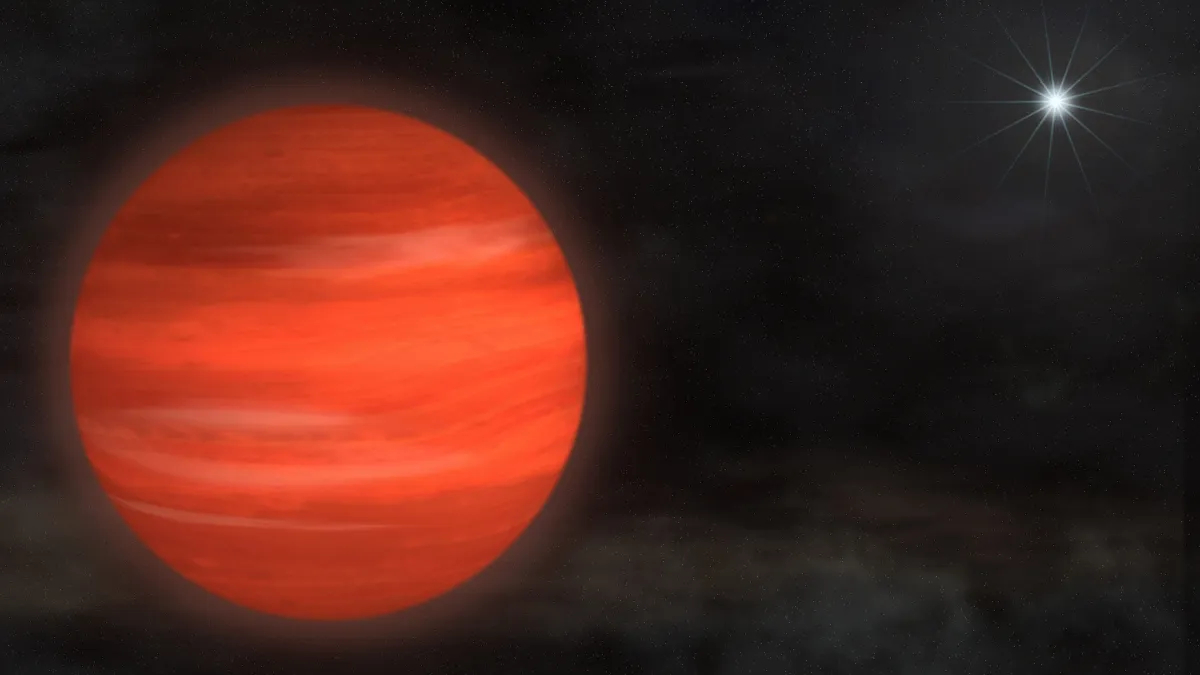
Based on new simulations, scientists believe that giant gas planets across the universe can often collide and merge into even bigger gas plants — behemoths called “super-Jupiters.”
In the cosmic scheme of things, it’s a little unusual that Jupiter is our solar system’s largest planet. Several other star systems boast giant gas planets at least five times more massive than Jupiter. Some of those “super-Jupiters” are, in fact, as large as it’s possible to be while still being considered a planet. A recent study simulated how such planets might form, and the results suggest that super Jupiters are the result of catastrophic collisions between gas giants.
Planetary pile-ups produce big results
Astronomers have wondered for years how super-Jupiters form. The central question is whether these gargantuan worlds were born huge (formed from unusually large clumps of gas and dust in the cloud of material swirling around a newborn star) or started out small and achieved super-size status by merging with other gas giants. The answer could help explain why our solar system missed out on its own super-Jupiter.
Flatiron Institute astronomer Jiayin Dong and her colleagues used computer models to watch the evolution of several simulated star systems, then compared their simulations to measurements of real gas giants’ masses and orbits. The researchers found that systems where gas giants collided tended to produce “super Jupiters” with orbits that looked most like the ones astronomers see in reality.
The most massive gas giants — planets more than five times Jupiter’s mass — tend to have orbits that look more like long, stretched-out ovals than circles. Astronomers describe these orbits as “eccentric,” and these trajectories can suggest a planet has a turbulent past, because gravitational pushes and pulls from other planets tend to warp a planet’s neat, circular orbit into an eccentric one. Super-Jupiters in particular tend to have more eccentric orbits than smaller, more Jupiter-like gas giants do, which suggests they formed in more turbulent star systems, where near-misses and full-on collisions between planets would have happened more often.
Smaller gas giants are less likely to survive in such systems, surrounded by clashing planetary titans. With their lower masses, they’re more likely to either get flung out of the system or pulled into a passing “super Jupiter” and added to its bulk.
“Our interpretation is that smaller warm Jupiters are more likely to get ejected, so it is a survivor bias that we observed,” Dong told Space.com.
Most monster planets are forged in catastrophe
When Dong and her colleagues simulated what would happen if planets started out unusually large and kept growing into super-Jupiters. They ended up with a mix of different types of orbits: round, wildly eccentric and everything in between. But when the researchers simulated what happened when gargantuan gas planets formed in a series of pile-ups of smaller planets, they got a bunch of “super Jupiters” with very eccentric orbits.
In the real universe, the largest super-Jupiters mostly whip around their stars in long, narrow ovals — just like the results of collisions between wandering giant planets in Dong and her colleagues’ simulations. And, according to the researchers, that’s enough to suggest that most super-Jupiters form in collisions powerful enough to fuse two gas giants together.
“However, it is always helpful to get more observational evidence, such as orbital inclination, atmospheric composition, etc.,” Dong said.
Hunting for massive worlds
In addition to that additional evidence, Dong and her colleagues want to measure the orbits of more super-Jupiters – and their smaller, more Jupiter-like neighbors.
The giant planets in the team’s recent study all orbit fairly close to their host stars; some zip around their stars once every few days, while others take up to three Earth years to make a full lap (for comparison, Jupiter orbits the sun once every 4,333 days). Astronomers call these gas giants “warm Jupiters,” so a really massive one would be a “warm super-Jupiter.” But Dong and her colleagues want to measure the orbits of not just warm super-Jupiters, but also cooler ones that orbit farther from their stars. That could reveal whether these more distant worlds formed through collisions, or whether they started out as lonely giants in the far reaches of their star systems.
Meanwhile, smaller worlds — for a definition of “small” that means “closer to the size of Jupiter, which is still a giant planet” — could help Dong and her colleagues put their recent conclusions to the test. In their recent round of simulations, super-Jupiters that form in a chain of planetary pile-ups tended to have smaller siblings, around the same mass as our Jupiter. But in simulated star systems where newborn planets happened to spawn from unusually large clumps of gas, all the planets were enormous super-Jupiters.
Dong says her team plans to use the Planet Finder Spectrograph, an instrument on the Magellan Telescope in Chile, and the NEID instrument on the WIYN 3.5-meter telescope in Arizona, to search for both smaller and more distant worlds in star systems with super-Jupiters. Both instruments measure how much a star wobbles as it’s tugged back and forth by an orbiting planet.
Article by:Source
























